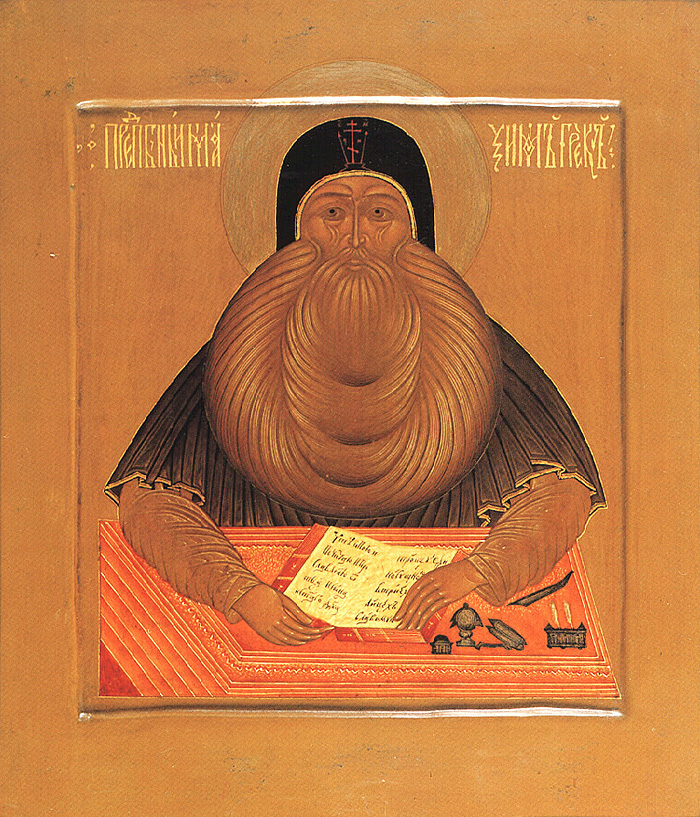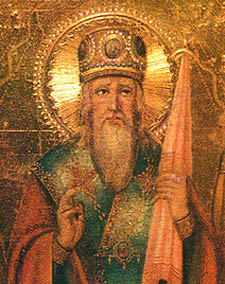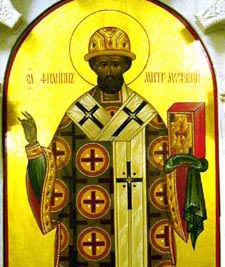Russia
The Victory of the Possessors
In Russia in the 16th century, the “Third Rome” theory became a political reality. In 1511, only one year after Moscow’s annexation of the important northwestern city of Pskov, the elderly, scholarly monk Philotheus of Pskov informed the Muscovite Tsar Basil III (r. 1505–1533) of his vision, based on the book of Daniel, that the Russian tsardom was to be the final earthly reign of God’s People.
According to Philotheus, the first Rome had fallen through heresy, and the second Rome, Constantinople, had fallen through sin. The third Rome, Moscow, was standing. And according to his interpretation of Daniel 2.44, it was the rising Muscovite tsardom that would be the kingdom that the “God of Heaven” was raising up which “shall never be destroyed . . . and it will stand forever.” Hence, he proclaimed with prophetic confidence that there would never be a fourth Rome.
The Monk Philotheus on Moscow as the Third Rome
It is through the supreme, all-powerful and all-supporting right hand of God that emperors reign . . . and It has raised thee, most Serene and Supreme Sovereign and Grand Prince, Orthodox Christian Tsar and Lord of all, who art the holder of the dominions of the holy thrones of God, of the sacred, universal and apostolic Churches of the most holy Mother of God . . . instead of Rome and Constantinople. . . . Now there shines through the universe, like the sun in heaven, the Third Rome, of thy sovereign Empire and of the holy synodal apostolic Church, which is in the Orthodox Christian Faith. . . . Observe and see to it, most pious Tsar, that all the Christian empires unite with thine own. For two Romes have fallen, but the third stands, and a fourth there will not be; for thy Christian Tsardom will not pass to any other, according to the mighty word of God.
Such a dramatic formulation of this powerful political/religious ideology, articulated by a devout monk of the Church, indicates to what extent the way was prepared for the development of an intimate alliance between Church and State in the Russian Empire.
The strengthening of this alliance was greatly hastened beginning in 1521, when Tsar Basil III presented the Church with a difficult dilemma. After many years of marriage, Basil’s wife had not given him any children. So he appealed to the Church for a divorce, in order to marry another who would presumably provide an heir to assure a peaceful succession to the throne. But in the Russian Church, barrenness was not a legitimate reason for divorce. Holding fast to the traditions, Metropolitan Varlaam of Moscow refused to allow the tsar to get divorced and remarried.
However, some in the Church, mostly following the Possessor philosophy of close relations between Church and State, felt that in this specific, extraordinary case, the strictness of the canons could be modified through pastoral economia, and an exception could be made, in the interest of ensuring that there would be a peaceful succession to the throne after Tsar Basil III’s death. One of those who openly promoted this view was the monk Daniel, a leading Josephite.
In 1522, Metropolitan Varlaam was forcibly retired to a monastery, and Daniel was made the Metropolitan of Moscow. In the next year, he celebrated the wedding of Tsar Basil III to Yelena Glinskaya. Seven years later, in 1530, the future tsar Ivan IV, “the Terrible,” was born of this marriage.

Once the Possessors came to political favor and power, they strove to suppress the Non-Possessors. For example, Saint Maxim the Greek (d. 1556), a skilled librarian from Mount Athos who had been invited by Tsar Basil III to come to Russia to help with translation and revision of the service books, was placed in confinement for twenty years for his support of the Non-Possessor position.
As Pierre Kovalevsky writes in Saint Sergius and Russian Spirituality, “The sketes beyond the Volga were closed, and the nationalist tendency definitely took the upper hand over the contemplatives. The idea of Russia as a ‘Third Rome,’ the protector of Eastern Christians, degenerated very quickly into Moscow as the ‘Third Rome,’ which was the only one to profess [true] Orthodoxy, and which considered all other people to be tainted with heresy.”
Ivan the Terrible
Tsar Ivan IV the Terrible (r. 1533–1584) established his reign on the foundation of the “Third Rome” ideology. He was crowned tsar in January of 1547. One month later he married Anastasia Romanova. As long as she lived, she had a salutary influence upon her impetuous, emotionally unstable husband. She bore him six children, but only two of them survived to adulthood.
Later in 1547, a huge fire in Moscow destroyed much of the city. To help in the rebuilding process, Ivan invited numerous technicians, printers, and physicians from the West. In 1550 a National Assembly was called, which approved a new legal code, allowing for extensive local self-government.
Three major local Church councils were held between 1547 and 1551. At the first two, forty-five saints from throughout Russia were glorified. And at the third one, known as the Council of One Hundred Chapters (Stoglav), many necessary reforms were instituted. This council proclaimed the ritual practices of the Russian Church to be superior to those of the other Orthodox Churches.
In 1552, Tsar Ivan conquered the Tatar Khannate of Kazan. In celebration of this victory, the great church on Red Square in Moscow, dedicated to Saint Basil the Blessed Fool for Christ, was built, with Oriental influence in its architecture. It became a national symbol of Russia.

In 1555 the missionary archdiocese of Kazan was established. According to Dimitry Pospielovsky in The Orthodox Church in the History of Russia, “Ivan’s missionary guidelines for the conquered Tatar kingdoms of Kazan and Astrakhan stipulated that conversions were to be only voluntary, by education and conviction, not by coercion.” Saint Gury (or Gurias; d. 1563), the bishop of Kazan, was influential in missionary outreach.
In these years Ivan accepted the guidance of a humble, country parish priest named Father Sylvester, who composed a tremendously popular practical guidebook for Christian family life called Domostroi (The Home-Builder).
Tragically, these “thirteen good years” came to an end in 1560. Ominously, one year before, having fallen under the influence of his courtiers who resented the high standing held by Father Sylvester, the simple country priest, Ivan ordered him to leave Moscow. The next year, on August 7, 1560, his beloved young wife suddenly died. He suspected that she had been poisoned.
Thereafter Ivan fell increasingly back to certain cruel tendencies of his youth. According to Nicolas Zernov, “No longer checked by her good influence, he plunged again into the dark passions and lusts of his early years. Ivan removed, one after another, by execution or exile, his gifted civil and military collaborators and surrounded himself with a crowd of base and unscrupulous men who drove him further along the road of moral disintegration.”
In 1563, Saint Metropolitan Makary (r. 1542–1563) died. He had written twelve volumes called Monthly Readings, a vast collection of commentaries on the Bible, the lives of the saints, sermons, and other material for spiritual reading. He also had had a calming influence on Tsar Ivan. But when he died, according to Pospielovsky, “Ivan’s paranoia lost all restraints.” Then, as Zernov relates, “Haunted by fear and suspicion, he embarked in 1564 on a social revolution which in many ways resembled the totalitarianism of the twentieth century.”

Tsar Ivan ruthlessly persecuted his enemies as he subjected both the Church and the State to his direct, personal control. Among his many victims was Saint Philip, Metropolitan of Moscow (r. 1565–1568), who, after numerous unfruitful private consultations with Ivan, dared to deny Holy Communion to the bloodthirsty tsar, openly rebuking him for his persecution of his own innocent people. The tsar had Philip imprisoned, and later strangled.
The last years of Ivan’s reign were filled with unrelieved misery as he continued to oppress and persecute all those he imagined were his enemies among his own people. After marrying for a fifth time, and after killing his son and heir, Ivan V, in a fit of rage, he finally died, in 1584.
Tsar Theodore
Ivan IV was succeeded by his younger son, Theodore (r. 1584–1598), a man with limited mental capacities. But his people loved him for his deep, simple faith and gentle disposition that were like a balm to the nation after the turmoil and terror of his father’s reign. Early on many mornings the people of Moscow would be roused by hearing their tsar ringing the bells of the Kremlin cathedral.
In 1587 the Patriarch of Constantinople, Jeremias II (r. 1572–1579, 1580–1584, 1585–1595), came to Moscow in quest of aid for his Church suffering under the yoke of the Ottoman Turks. Seeing this as their opportunity for Moscow to be made a patriarchate, the Russians invited Jeremias to be their patriarch. Apparently he considered the offer for some time, but in January of 1589, in the midst of his second long winter in Moscow, he recognized Job, the Metropolitan of Moscow, as the first Patriarch of All Russia.
The installation document of the new patriarch repeated almost verbatim the prophecy of Philotheus of Pskov about Moscow as the “Third Rome.” Thus the theory, which had become practice under Basil III, was now officially affirmed by the highest ranking prelate in the Orthodox Church.
In 1593 the Russian Church received approval of its new status as a patriarchate from the patriarchs of Jerusalem, Alexandria, and Antioch. The Russians accepted their new patriarchate being placed fifth in honor after the four ancient Orthodox patriarchates.
